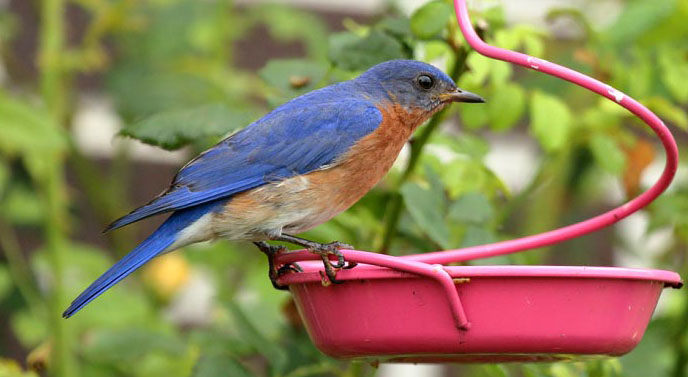Unlike many birds who will feed under a wide variety of circumstances, the bluebird is shy – so your blue bird feeder needs to be carefully selected for best results.
Because the bluebird is shy, it does not normally visit feeders. If you’d like to attract bluebirds to your feeder, it is best to begin training them to your feeder in the early spring, as they are returning to their nesting areas.
Bluebirds prefer to eat insects and fruit, and one of the more readily available foods is raisins – which should be soaked in water to plump and soften them before adding them to your feeder.
Another common “feeder food” for bluebirds is freeze dried mealworms, which are highly nutritious, and live mealworms are another option. Indeed, the movement of live mealworms is an excellent way to attract bluebirds to your feeder when first training them.
There are special foods for bluebirds which contain the proper balance of nutrition, and you may prefer to purchase such a ready-made feed. Other bluebird enthusiasts make their own feed from peanut butter or suet and bits of soft fruit.
When considering the food options for bluebirds, it becomes clear that the best variety of feeder has a large tray to hold the fruit and mealworms. While bluebirds will certainly eat some seeds, so will many other birds, and because bluebirds are shy, the other birds will often frighten them away.
If you intend to feed your bluebirds live mealworms, another problem is that mealworms – like most worms – have a certain tendency to crawl up the sides of the tray and get out of the feeder altogether. Your feeder should have a rolled edge to trap the mealworms, and prevent their escape.
To handle the shyness of bluebirds, it’s common to obtain a feeder which allows the bluebirds to feed entirely inside it – flying in to actually sit in the food tray, and remain comfortably safe from other birds. A dome feeder can work, but is not ideal, and many of them lack the rolled edge necessary to retain live mealworms.
These feeders should have small entry holes, to keep out larger and more aggressive birds. If you’d like to watch the birds feed, you’ll want to get a feeder with transparent acrylic or glass sides. Some bluebird feeders mount directly onto windows, and boast an open back to provide the closest and clearest view of your feeding bluebirds.
When using an enclosed feeder with transparent sides, it is advisable to put small horizontal strips of tape on the glass, so they do not become confused and unable to leave. Keeping it clean and well-stocked should be all you need to do, once the birds have gotten accustomed to it.
Once you’ve selected a proper blue bird feeder and stocked it with appropriate feed, placing it within easy view of your local bluebirds’ favorite perch – especially with a few live mealworms in the mix – can draw them to it within days.
